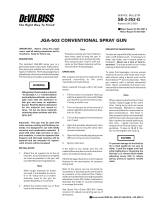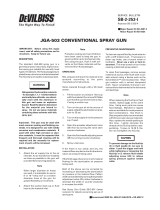
SB-E-DA-100-A
DA-100
LVMP
AUTOMATIC SPRAY GUN
OPERATION MANUAL
IMPORTANT: Read and follow all instructions and SAFETY PRECAUTIONS before using this
equipment.
DESCRIPTION
DA-100 LVMP gun is developed to achieve high transfer efficiency and it can be obtained as well as
high atomization with less air consumption. LVMP stands for Low Volume Medium Pressure.
Small, lightweight LVMP gun is suitable for installing to automatic or semi-automatic machines.
Models and application information follows.
MODELS
Example:
DA - 100 -
1
20
Basic Part No. Fluid Tip Size 0.8, 1.1, 1.4, 1.8 mm
Air Cap No. 205, 207
NOTE: The gun body and fluid passage is made of Aluminum. Please do not use the gun with
chlorinated solvents or waterborne paint.
Chart 1
Air Cap
Marking Part No.
Fluid Tip Size
(mm)
Pattern Size
Shape
Typical Applications
205 JJ-3-205 0.8, 1.1, 1.4, 1.8
250mm
Straight
Most conventional materials
207 JJ-3-207 0.8, 1.1, 1.4, 1.8
300mm
Straight
Most conventional materials
Chart 2
Air Cap Tip Marking (mm)
Part Number
(Tip & Needle Lapped Set)
0.8 DA-400-0.8
1.1 DA-400-1.1
1.4 DA-400-1.4
205, 207
1.8 DA-400-1.8

SAFTEY PRECAUSTIONS
This manual contains important information that ALL users should know and understand BEFORE using
this equipment. This information relates to USER SAFETY and PREVENTING EQUIPMENT PROBLEMS.
To help you recognize this information, we use the following terms to draw your attention to certain
equipment labels and portions of this manual. Pay special attention to any label or information that is
highlighted by one of these terms:
WARNING
Important information to alert you to a situation that might cause serious injury or loss
of life if instructions are not followed.
CAUTION
Important information that tells how to prevent damage to equipment.
NOTE
Information that you should pay special attention to.
WARNING
The following hazards may occur during the normal use of this equipment. Please read the following chart.
HAZARD CAUSE SAFEGUARDS
Fire Solvents and coatings can be
highly flammable or
combustible,
especially when sprayed.
1. Adequate exhaust must be provided to keep the air
free of accumulations of flammable vapors.
2. Smoking must never be allowed in spray area.
3. Fire extinguishing equipment must be present in the
spray area.
4. Static discharges must be prevented. Ground (earth)
all conductive objects in the spray area, such as a
cleaning solvent bucket, fire extinguisher, etc.
5. When using solvents for cleaning;
Those used for equipment flushing must have a flash
point equal to or greater than that of the coating.
Those used for general cleaning must have flash
points above 100 F(37.8 ).
Inhaling Toxic
Substances
Certain materials may be
harmful if inhaled, or if there
is contact with the skin.
1. Follow the requirements of the Material Safety Data
Sheet supplied by coating material manufacturer.
2. Adequate exhaust must be provided to keep the air
free of accumulations of toxic materials.
3. Use a mask or respirator whenever there is a chance
of inhaling sprayed materials. The mask must be
compatible with the material being sprayed and its
concentration. Equipment must be as prescribed by
an industrial hygienist or safety expert, and be NIOSH
approved.
Explosion Hazard-
Incompatible
Materials.
Halogenated hydrocarbon
Solvents- for example:
methylene chloride and 1,1,1,
-Trichloroethane are not
chemically compatible with
the aluminum that might be
used in many system
components. The chemical
reaction caused by these
solvents reacting with
aluminum can become violent
and lead to an equipment
explosion.
The T-AGB spray gun can be used with these
solvents.
However, aluminum is widely used in other spray
application equipment – such as material pumps,
cups, regulators, valves, etc.
Check all other equipment items before use of these
solvents. Read the label or data sheet for the
material you intend to spray. If in doubt as to where
or not a coating or cleaning material is compatible,
contact your material supplier.
2

HAZARD CAUSE SAFEGUARDS
General Safety Improper operation or
maintenance may create a
hazard.
Operators should be given adequate training in the
safe use and maintenance of the equipment (in
accordance with the requirements of NFPA-33,
Chapter 15 in U.S.). Users must comply with all
local and national codes of practice and insurance
company requirements governing
ventilation, fire precautions, operation, maintenance
and housekeeping (in the U.S., these are OSHA
Sections 1910.94 and 1910.107 and NFPA-33).
Noise Levels The continuous A-weighted
sound pressure level of this
spray gun may exceed
85dB(A) depending on the air
cap/nozzle set-up being
used. Sound levels are
measured using an impulse
sound level meter and
analyzer, when the gun is
being used in a normal
spraying application. Details
of actual noise levels
produced by the various air
cap/nozzle set-ups are
available on request.
Wear earplugs when using the spray gun.
Spraying solvent Pressured air/fluid passage
may be broken when
cleaning or flashing with
solvent.
The solvent may be harmful
if contacted with eyes.
Always wear eye protection when spraying or
cleaning the equipment.
MISUES:
All spray guns project particles at high velocity and must never be aimed t any part of body.
Never exceed the recommended safe working pressure for any of the equipment used.
The fitting of non-recommended or non-original accessories or spare parts may create hazardous
conditions.
Before dismantling the equipment for cleaning or maintenance, all pressures, air and material, must be
isolated and released.
Disposal of non-metallic materials must be carried out in an approved manner. Burning may
generate
toxic fumes. The removal of waste solvents and coating materials should be carried out by an
authorised local waste disposal service.
3

SPECIFICATION
Max. Air Pressure: 0.69MPa (6.9 bar)
Max. Fluid Pressure: 0.69MPa (6.9 bar)
Cylinder Air Pressure: Min. 0.35MPa (3.5 bar)
Max. 0.50MPa (5.0 bar)
Weight: 480g
Gun Stud Diameter: 16.0mm
Fluid Thread: G1/4 (M) CAP Thread: G1/4 (M)
CYL Thread: G1/4 (M)
INSTALLATION
Figure 1. Dimensions
Mount the gun with the set screw (22).
NOTE:
The air supplied to the gun should be clean air that removed any impurities. Also, the air hose
should have enough inner diameter depending on the length to supply necessary air.
OPERATIONS
1. Mix, prepare and strain the coating material to be sprayed according to paint manufacture’s instructions.
2. Adjust the CYL air at 0.35 Mpa ~. Please use air regulator for setting the air pressure for the smooth
movement of CYL.
3. Turn Needle Adjusting Knob counter-clockwise 3.5 turns from fully closed position. This makes the Needle
fully opened.
4. Adjust CAP air at 0.20Mpa.
5. Adjust fluid pressure at about 0.07Mpa~0.1Mpa.
6. Turn on CYL air and test spray. Adjust fluid and air pressure until desired pattern is obtained. Pattern size
can be adjusted by using pattern valve (5). Control fluid pressure at supply source. Always attempt to
keep CAP pressure as low as possible to minimize overspray and control the air at air supply source.
WARNING
Risk of injury. Equipment and fluid may be under pressure. Pressure in the system must be
relieved before beginning the cleaning procedure and before replacing any parts. Follow the
procedures in the literature provided with the system.
4

5
CLEANING
1. Relieve air pressure from pressure tank. Carefully follow instructions in bulletin sent with tank.
2. Replace material in container with a suitable solvent.
3. Repressurize system.
4. Trigger gun and repeat procedure until gun and hose are thoroughly clean. A SolventSaver
TM
type hose
and gun cleaner which supplies a mixture of air and solvent can be used to most effectively clean gun and
hose internal passages. See “Accessories” for SolventSaver
TM
.
5.Wipe exterior of gun with a solvent dampened cloth.
CAUTION
Do not totally submerge gun in solvent. It is possible for wash solids to flow into air operating
sections of gun which could seriously damage piston “O” Ring seals.
CAUTION
The air cap can be immersed in solvent for cleaning and brush the gun. If orifices are clogged,
use a broom straw or toothpick to remove obstruction. Never use a steel wire or hard instrument.
This will damage air cap and result in a distorted spray pattern.
REPLACEMENT
Tools Required
•
•
•
•
Crescent Wrench or Spanner
19mm Box Wrench or Hex Wrench (for Item No. 4)
Pliers (for Needle Assy)
Large Minus Screw Driver
Fluid Tip, Fluid Needle (4), Needle Packing (6)
1. Relieve all air and fluid pressure in system.
2. Remove Retaining Ring (1) and Air Cap (2).
3. Remove Fluid Tip (3)
4. Replace Fluid Tip and Needle at the same time with the lapped set. It is recommended to replace
needle packing (6) at the same time as replacing the tip and needle.
5. Remove Ratchet Assy. (18) and Pull Needle Assy. out from gun body with Pliers.
6. Remove Cover (20), Packing Gland (7) and take out Needle Packing (6)
7. Reassemble in reverse order. It is recommended to put Gun lube (SSL-10) slightly between needle
and needle packing.
8. Recommended torque of Fluid Tip: 20~11N.m.
Piston Cup (13), Air Valve (11), O-Ring (8), Gasket (9)
1. Remove Ratchet Assy. (18) and Pull Needle Assy. out from gun body.
2. Screw Needle (from the rear side) in Piston Cup (13) and pull Needle to take out Piston Cup.
3. Turn Air Valve (11) counter-clockwise with proper tool putting in the slot and remove it.
4. Remove O-Ring (8) and Gasket (9).
5. Wipe the inside of cylinder and clean it. Apply non-silicone grease lightly on O-Ring.
6. Reassemble in reverse order.
Fluid Inlet (19), Air Connector (22)
1. When Remove Fittings and reassemble the gun, remove the sealing material from the gun body and
fittings completely.
2. Put the new sealing material (Loctite 242, etc.) on the thread part of fittings when reassemble.

Figure 5. Gun Exploded View
Parts Sheet
6

SERVICE CHECK
Normal Spray Pattern
The proper combination of fluid pressure, fan and atomization air pressure,
and fluid tip size should result in a pattern of this shape.
PROBLEM CAUSE CORRECTION
Will not spray. No pressure to gun.
Piston stops moving.
Check air and material lines.
Check CYL air pressure.
A. Gun not adjusted properly.
A, B Material build up on the air
cap (2)or fluid tip (3).
A. Re-adjust. See “Operation
Section”.
A, B Clean the air cap or fluid tip.
See “Preventive Maintenance”.
Note
To determine where the material build up is, rotate the air cap 180 and test
spray. If the pattern stays in the same position, the condition is caused by
material build up on the fluid tip. If the pattern changes with air cap movement,
the build up is in the air cap.
Improper spray
pattern.
C, D. Wrong material or material
too thick.
Insufficient material or
atomizing air pressure too
high.
C, D Adjust material pressure or thin
material.
Increase material or reduce
atomizing air pressure.
Jerky or fluttering
spray.
1.
2.
3.
4.
1.
2.
3.
4.
Insufficient material in the tank
or an obstruction in the line.
Gun material passage plugged.
Worn Needle Seal Kit (7).
Loose or damaged fluid tip.
Fill tank or clear obstruction.
Clean.
Replace.
Tighten or replace.
Air leaking from
Adjusting Screw (20).
1.
2.
1.
2.
Damaged or worn Piston Cup
(14).
Damaged cylinder of Gun Body
(6).
Replace.
Replace.
Dripping from Fluid
Tip.
1.
2.
3.
1.
2.
Worn or damaged Fluid Tip (2)
or Needle (12).
Needle Spring (18) damaged or
deformed.
Replace.
Replace.
Air or fluid leaking
from Gun Body (6).
Damaged or worn Needle Seal Kit
(7)
Replace.
ACCESSORIES
PART NUMBER DESCRIPTION
SSL-10 Gun Lube (60ml)
42884-214-K5 Cleaning Brush (Kit of 5)
AGA-415 Universal Clamp
GC-100-K48 Gun Cover (Kit of 48)
HD-505 Quick Cleaner (5L)
QMGZ-5200 Solvent Saver (10L)
7
/










